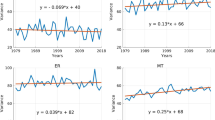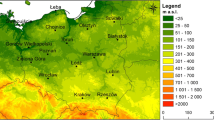Abstract
Analyses of 60 years (1949–2008) of monthly energetics of the zonal waves derived from NCEP/NCAR data indicate that ultra-long waves (waves 1 and 2) dominate the spectrum of lower tropospheric zonal waves during monsoon season (June–September). Westerlies over the Indian subcontinent are a source of energy to wave 1. Two oceanic anticyclones, one over Pacific and the other over Atlantic are sources of energy to wave 2. These two waves are inversely correlated. Climatology of the energetics of ultra-long waves for the two epochs 1949–1978 (CLP1) and 1979–2008 (CLP2) of 30 years indicates that the intensity of wave 1 has decreased by about 33% whereas the intensity of wave 2 has increased by about 27%. Northward transport of sensible heat during CLP1 changes to southward during CLP2. Larger generation of zonal mean Available Potential Energy (APE) during CLP2 indicates more heating. A larger conversion of kinetic energy (KE) of wave 1 into APE of wave 1 leads to weakening of wave 1 during CLP2. In case of wave 2, lower rate of conversion of KE to APE leads to stronger wave 2 during CLP2.











Similar content being viewed by others
References
Bawiskar S M, Awade S T, and Singh S S 1989 Harmonic analysis of summer wind at 200 mb level during contrasting monsoon years over India; Proc. Indian Acad. Sci. (Earth Planet. Sci.) 98 (4) 365–373.
Bawiskar S M, Chipade M D, Mujumdar V R, Bhide U V, and Singh S S 2005a Contrasting features of wave number one during northern summer monsoon seasons of 1997 and 2002; Mausam 56 (2) 337–342.
Bawiskar S M, Chipade M D, Mujumdar V R, Puranik P V, and Bhide U V 2005b Kinetic energy of extra-tropical waves and their effect on the Indian monsoon rainfall; Mausam 56 (3) 681–685.
Bawiskar S M 2009a Weakening of lower tropospheric temperature gradient between Indian land mass and neighbouring oceans and its impact on Indian monsoon; J. Earth Syst. Sci. 118 (4) 273–280.
Bawiskar S M, Chipade M D, and Puranik P V 2009b Energetics of lower tropospheric ultra-long waves: A key to intra-seasonal variability of Indian monsoon; J. Earth Syst. Sci. 118 (2) 115–121.
Bedi H S, Billa H S, and Mukarjee N 1981 Interaction between northern middle latitude and summer monsoon circulation; Int. Conf. on early results of FGGE and large scale aspects of monsoon experiment GARP, Tallahassee, Florida, pp. 5-25–5-29.
Jadhav S K and Munot A A 2008 Warming SST of Bay of Bengal and decrease in formation of cyclonic disturbances over Indian region during southwest monsoon season; Theor. Appl. Clim. 96 (3–4) 327–336, doi: 10.1007/s00704-008-00434-3.
Joseph P V 1998 Introduction to meteorology; Lecture Notes, unit: 1 Module: 1.1, Published by Space Application Centre, Indian Space Research Organisation, Ahmedabad.
Kalnay E, Kanamitsu M, Kistler R, Collins W, Deaven W, Gandin L, Iredell M, Saha S, White G, Woollen J, Zhu Y, Leetmaa A, Reynolds R, Chelliah M, Ebisuzaki W, Higgins W, Janowiak J, Mo K C, Ropelewski C, Wang J, Jenne R, and Joseph D 1996 The NCEP/NCAR 40-year reanalysis project; Bull. Am. Meteor. Soc. 77 437–471.
Kanamitsu M 1981 Analysis of monsoonal quasi-stationary systems as revealed in a real-data prediction experiment; In: Monsoon dynamics (eds) Sir James Lighthill and Pearce R P, Cambridge University Press, pp. 147–164.
Kothawale D R, Munot A A, and Borgaonkar H P 2008 Temperature variability over the Indian Ocean and its relationship with Indian summer monsoon rainfall; Theor. Appl. Climatol. 9 31–45.
Krishnamurti T N and Bhalme H N 1976 Oscillations of a monsoon system: Part I. Observational aspects; J. Atmos. Sci. 33 1937–1954.
Krishnamurti T N and Kanamitsu M 1981 Northern summer planetary scale monsoon during drought and normal rainfall months; In: Monsoon dynamics (eds) Sir James Lighthill and Pearce R P, Cambridge University Press, pp. 19–48.
Murakami T 1976 Cloudiness fluctuations during the summer monsoon; J. Meteor. Soc. Japan 54 175–181.
Murakami T 1981 Summer mean energetics for standing and transient eddies in wave number domain; In: Monsoon dynamics (eds) Sir James Lighthill and Pearce R P, Cambridge University Press, pp. 65–80.
Paul D K, Mujumdar V R, Puranik P V, Ghanekar S P, Deshpande V R, and Sikka D R 1990 Fluctuations of regional scale atmospheric features in relation to monsoon activities; Mausam 41 (2) 309–314.
Pisharoty P R and Desai B N 1956 Western disturbances and Indian weather; Indian J. Met. Geophys. 74 333–338.
Saltzman B 1970 Large-scale atmospheric energetics in the wave number domain; Rev. Geophys. Space Phys. 8 289–302.
Sikka D R and Grey W M 1981 Cross-hemispheric actions and the onset of the summer monsoon over India; Int. Conf. on Sci., Results of monsoon experiments, Bali, Indonesia 26–30 Oct., pp. 3.74–3.78.
Acknowledgements
The authors are thankful to Prof. B N Goswami, Director, Indian Institute of Tropical Meteorology, Pune for his keen interest in the study. The authors are also grateful to Dr. A K Sahai, Chief Project Scientist, Model Development and Prediction – Extended Range Prediction, Indian Institute of Tropical Meteorology, Pune for the encouragement.
Author information
Authors and Affiliations
Corresponding author
Rights and permissions
About this article
Cite this article
Chipade, M.D., Kulkarni, J.R. & Bawiskar, S.M. Impact of global warming on the energetics of lower tropospheric ultra-long waves and the Indian summer monsoon. J Earth Syst Sci 123, 1739–1747 (2014). https://doi.org/10.1007/s12040-014-0499-8
Received:
Revised:
Accepted:
Published:
Issue Date:
DOI: https://doi.org/10.1007/s12040-014-0499-8




